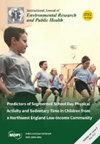高能量、低纤维饮食模式可能是巴西肥胖率上升的主要原因
3区 综合性期刊
Q1 Medicine
International Journal of Environmental Research and Public Health
Pub Date : 2024-08-07
DOI:10.3390/ijerph21081038
引用次数: 0
摘要
混合方法是提取与健康结果相关的膳食模式的合适选择。本研究旨在确定巴西成年人(20-59 岁;n = 28153)与肥胖风险相关的膳食成分有关的膳食模式。研究分析了 2017-2018 年巴西全国膳食调查的数据。食物消耗量通过 24 小时回忆获得。以能量密度(ED)、总脂肪百分比(%TF)和纤维密度(FD)作为响应变量,使用偏最小二乘法回归提取膳食模式。此外,还将 32 个食物组作为模型中的预测变量。第一种膳食模式被命名为能量密度和低纤维(ED-LF),包括固体脂肪、面包、添加糖的饮料、快餐、调味汁、面食和奶酪的正因子载荷,以及米饭、豆类、蔬菜、水和水果的负因子载荷(≥|0.15|)。年龄大于 40 岁、来自城市地区、收入水平最高、不节食、报告在家以外的食物消费和每天≥1 次零食的人对 ED-LF 饮食模式的依从性较高。饮食模式的特点是水果、蔬菜和主食摄入量低,而快餐和含糖饮料摄入量高,这可能是造成巴西肥胖的原因之一。本文章由计算机程序翻译,如有差异,请以英文原文为准。
Energy-Dense and Low-Fiber Dietary Pattern May Be a Key Contributor to the Rising Obesity Rates in Brazil
Hybrid methods are a suitable option for extracting dietary patterns associated with health outcomes. This study aimed to identify the dietary patterns of Brazilian adults (20–59 years old; n = 28,153) related to dietary components associated with the risk of obesity. Data from the 2017–2018 Brazilian National Dietary Survey were analyzed. Food consumption was obtained through 24 h recall. Dietary patterns were extracted using partial least squares regression, using energy density (ED), percentage of total fat (%TF), and fiber density (FD) as response variables. In addition, 32 food groups were established as predictor variables in the model. The first dietary pattern, named as energy-dense and low-fiber (ED-LF), included with the positive factor loadings solid fats, breads, added-sugar beverages, fast foods, sauces, pasta, and cheeses, and negative factor loadings rice, beans, vegetables, water, and fruits (≥|0.15|). Higher adherence to the ED-LF dietary pattern was observed for individuals >40 years old from urban areas, in the highest income level, who were not on a diet, reported away-from-home food consumption, and having ≥1 snack/day. The dietary pattern characterized by a low intake of fruits, vegetables, and staple foods and a high intake of fast foods and sugar-sweetened beverages may contribute to the obesity scenario in Brazil.
求助全文
通过发布文献求助,成功后即可免费获取论文全文。
去求助
来源期刊

International Journal of Environmental Research and Public Health
Medicine-Public Health, Environmental and Occupational Health
CiteScore
7.30
自引率
0.00%
发文量
14422
审稿时长
1 months
期刊介绍:
International Journal of Environmental Research and Public Health (IJERPH) (ISSN 1660-4601) is a peer-reviewed scientific journal that publishes original articles, critical reviews, research notes, and short communications in the interdisciplinary area of environmental health sciences and public health. It links several scientific disciplines including biology, biochemistry, biotechnology, cellular and molecular biology, chemistry, computer science, ecology, engineering, epidemiology, genetics, immunology, microbiology, oncology, pathology, pharmacology, and toxicology, in an integrated fashion, to address critical issues related to environmental quality and public health. Therefore, IJERPH focuses on the publication of scientific and technical information on the impacts of natural phenomena and anthropogenic factors on the quality of our environment, the interrelationships between environmental health and the quality of life, as well as the socio-cultural, political, economic, and legal considerations related to environmental stewardship and public health.
The 2018 IJERPH Outstanding Reviewer Award has been launched! This award acknowledge those who have generously dedicated their time to review manuscripts submitted to IJERPH. See full details at http://www.mdpi.com/journal/ijerph/awards.
 求助内容:
求助内容: 应助结果提醒方式:
应助结果提醒方式:


